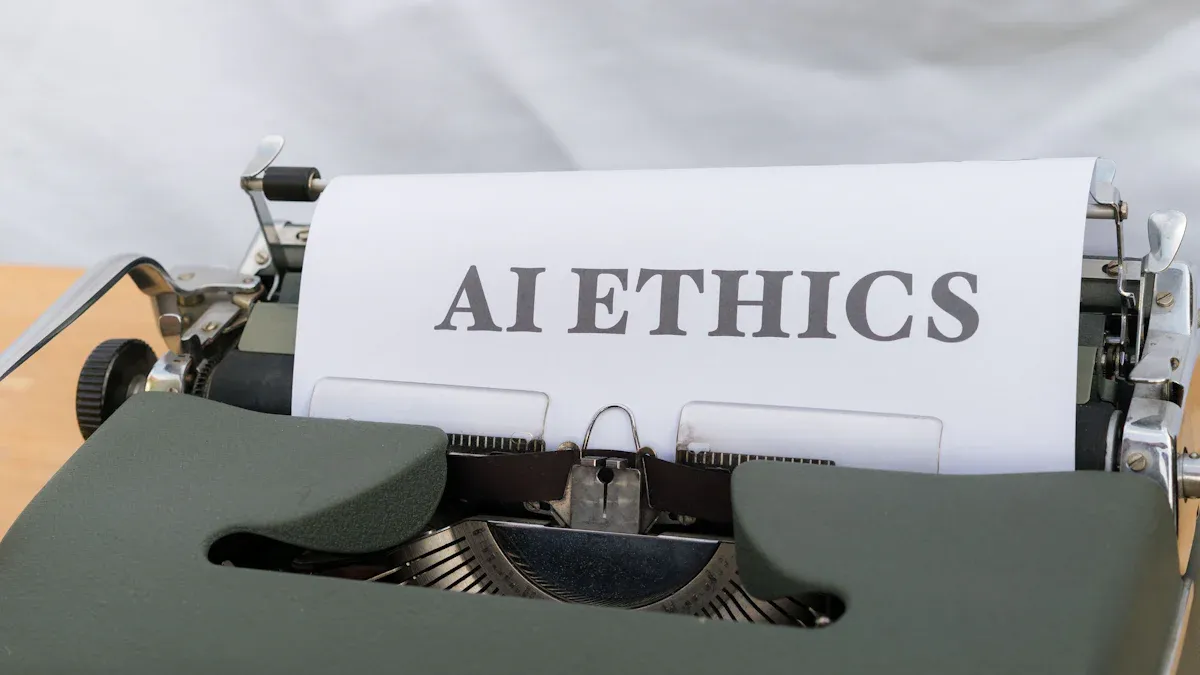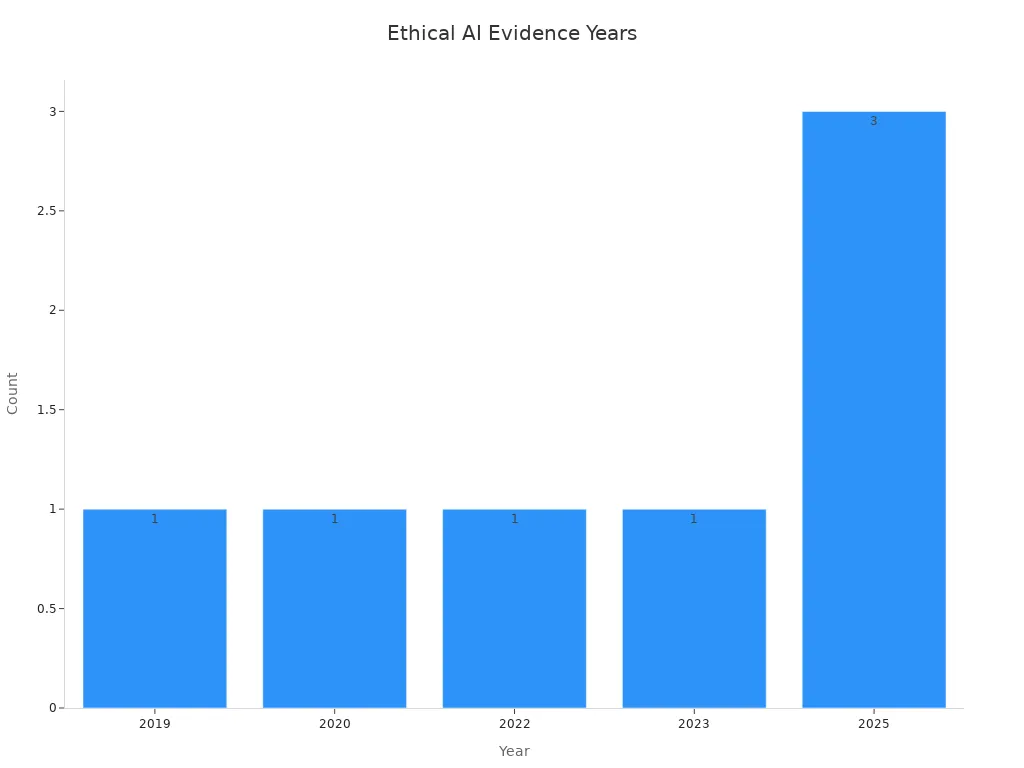Ethical Guidelines for AI-Generated Blogging

You now see AI-generated blogging in many places. Generative AI tools are changing how people make content. ChatGPT, for example, got 100 million users in two months. This shows how fast AI is shaping your online world. Because of this growth, ethical guidelines are very important. You need to be open and make sure all content is fair and correct. As AI does more, your job gets bigger. Always be honest and follow the rules when you make or share content. Risks like bias, privacy, and plagiarism need careful attention.
Key Takeaways
Always look over AI-generated content for truth, fairness, and new ideas before you share it. Make sure a person checks the work to find errors and to keep your values in the content. Tell your readers clearly when AI helped make the content. Follow copyright and privacy rules so your work stays legal and people can trust it. Pick AI tools that use green energy and good habits to help the environment.
Ethical Guidelines
Core Principles
You help shape the future of AI-generated blogging. When you follow ethical guidelines, people trust you more. These rules help you make good content and keep everyone safe.
A report from Capgemini Research Institute (2023) says transparency, innovation, and ethical adoption are important in content marketing. Studies like Khan et al. (2022) say transparency, fairness, privacy, and accountability matter most for using AI the right way. You should remember these ideas when you use AI tools for blogging.
Tip: Always check if your content is fair and correct when using AI. This stops you from sharing bias or wrong information.
Here is a table that shows what recent research and reports found:
Source & Year | Type of Evidence | Key Ethical Principles or Findings | Relevance to AI-Generated Blogging Ethics |
|---|---|---|---|
Capgemini Research Institute, 2023 | Industry report | Transparency, innovation, ethical adoption | Shows real-world ethical guidelines in content creation |
Khan et al., 2022 | Systematic review | Transparency, fairness, privacy, accountability | Supports core ethical guidelines for blogging |
Jobin et al., 2019 | Academic study | 84 global AI ethics guidelines | Provides a broad base for ethical standards |
Hagendorff, 2020 | Academic evaluation | Critiques lack of enforcement in AI ethics | Stresses need for accountability and oversight |
Huanga et al., 2025 | Systematic mapping review | Bias and stereotype reproduction | Highlights fairness and non-discrimination |
Frontiers in Communication, 2025 | Academic study | 8 ethical factors for GenAI in brand content | Offers validated ethical guidelines for blogging |
Thesify.ai, 2025 | Industry guide | Best practices for originality and verification | Emphasizes responsible and ethical use of AI |
You can see that people care more about ethical standards now than before:

Big schools like Oxford, Cambridge, MIT, and Stanford have rules for using AI the right way. They say AI should help you, not do all your work. You can use AI to get ideas, plan topics, and organize your writing. But do not let AI do all the hard thinking for you. Always check what AI gives you with trusted sources and do your own research to make your work better.
When you follow these rules, you respect other people’s work, treat everyone fairly, and take responsibility for what you write. These standards help you avoid problems like bias, copying, and privacy issues.
Human Oversight
You always need to keep human oversight in AI-generated blogging. AI can help you write faster, but it cannot replace your choices or ideas. Oversight makes sure your work is ethical and matches your values.
Note: Human review helps catch mistakes, bias, and bad content.
Here are some easy ways to keep good oversight:
Look over all AI-made content before you post it.
Make sure it is correct, fair, and original.
Use tools to check for copying.
Tell your readers when you use AI so you are honest.
Change your rules as AI gets better.
Some studies, like Hagendorff (2020), say many AI ethics rules are not enforced. You must take charge of your work and be responsible. This helps people trust you and supports ethical AI use in blogging.
You should also learn about new rules and ideas for ethics. AI ethics changes fast. If you keep learning, your content will stay good and trustworthy.
AI-Generated Content
Definition
You see ai-generated content almost everywhere now. This kind of content is made by ai algorithms. These can create text, pictures, sounds, and videos. The ColorWhistle document says ai-generated content uses smart technology like large language models, such as GPT-3. These tools help make content easier to create and organize. You can use generative ai to write blogs, make pictures, or even create music. Ai-generated content works in many areas, like natural language processing, image recognition, and voice recognition. These tools help you finish work faster and reach more people. In blogging, ai can help you think of ideas, write drafts, or edit your work. Generative ai does not take away your creativity. It gives you new ways to share your thoughts. Ai-generated content helps with regular content making and lets you keep up with fast online publishing.
Tip: Use ai-generated content to help your work, but always check and make it your own.
Use Cases
You can find many real examples of ai-generated content in blogs and media. Generative ai helps you write stories, sum up news, and make social media posts. Ai in blogging lets you do simple tasks faster, so you have more time for creative work. But you need to be careful. Sometimes, generative ai makes up fake facts or wrong sources. For example, ChatGPT (GPT-3.5) gives fake references about 40% of the time. GPT-4 does this about 29% of the time. Ai-generated content can also cause legal trouble if it makes up cases or facts. Tools like OpenAI Classifier and Copyleaks try to find ai-generated content, but they are not always right.
Use Case / Issue | Example / Statistic | Implication / Description |
|---|---|---|
Fabricated citations by ai | ChatGPT (GPT-3.5) produces fake references ~40% of the time; GPT-4 about 29% | Ai-generated academic content might have fake sources, which can hurt research trust. |
Lawyer cited nonexistent legal cases generated by ai | Ai can make up legal cases, causing big mistakes and showing ai can be wrong. | |
Ai content detection accuracy | Tools to find ai-generated content work differently, so it is hard to always know if text is ai-made. | |
Misinformation via deepfakes and fake news | Ai-generated deepfake audio nearly fooled thousands during 2024 elections; false info spreads faster on social media | Ai can make lots of fake news, which can trick people and spread wrong information. |
Ai hallucination tendency | Newer ai models avoid saying 'I don’t know' and confidently produce plausible but incorrect answers | There is a bigger chance of hidden mistakes in ai-generated content, which can hurt things like health advice and history. |
You should use ai-generated content to make content faster and help your ideas. Always check the facts and have people review the work to stop mistakes. Ai tools for blogging are strong, but you must use them the right way.
Ethical AI Concerns

Bias and Fairness
When you use ai for blogging, you face real problems. Bias in ai can make things unfair. Tools like Google’s What-If and Facebook’s Fairness Flow help you find bias. These tools show if content is unfair to people by race, gender, or age. Many studies say datasets are not balanced. This can put bias into the ai. For example, hiring tools might not treat all groups the same. They may miss or mislabel some people. You can fix this by checking your data often and using many types of data. In healthcare, experts say to do random tests and keep checking for bias. You should always watch your ai and use systems that explain their choices. This helps people trust your work. These actions help you follow ai ethics rules.
Misinformation
Misinformation is a big problem with ai-made content. Ai can make up fake stories that spread fast online. Studies show ai-made fake news goes viral, even from small accounts. People like this content because it is fun and easy to read. This makes it seem true. The table below shows some important facts:
Statistical Finding | Description |
|---|---|
Virality of AI-generated misinformation | More likely to go viral, even from small accounts |
Detection difficulty | People detect ai-generated misinformation only 59% of the time |
Compelling nature | Ai-generated misinformation is easier to read and harder to spot |
User deception | People get fooled by ai-generated misinformation more than by human content |
You should always check facts and review content before you share it. This stops fake news from spreading and keeps your readers safe.
Plagiarism
Plagiarism is also a problem with ai-made content. Sometimes, ai copies text from its training data. This can include things that are copyrighted. You need to check if your work is original and give credit when needed. Many websites use plagiarism checkers to find copied parts and suggest citations. Tools like MRCCWiz help you give proper credit. Academic journals use software to find copied work too. Always say when you use ai and check every citation. Ai can make up fake sources, so you must double-check them. These steps keep your work honest and fair.
Privacy
Privacy is a big worry in ai blogging. Ai models use huge sets of data, which can have personal info taken without asking. In 2023, Italy stopped ChatGPT because of privacy worries. The European Data Protection Board made a group to watch how ai uses personal data. In the United States, some people sued ai companies for using private and copyrighted data without asking. OpenAI’s training set has over 200 million copyrighted items, which makes privacy risks bigger. Hackers can attack ai systems to steal private info. Lawsuits, like the one from the New York Times, show that privacy and copyright fights are growing. You must keep user data safe, follow privacy laws, and use ai the right way to avoid these problems.
Responsible Content Creation
You are important in making trustworthy ai-generated content. You need to use both ai and your own ideas. This helps you keep your work correct and clear. It also makes your content good quality.
Fact-Checking
Fact-checking is the first thing you should do. Ai can make things fast, but it is not always right. You must check every fact before you share it. Experts like Temmo Kinoshita and Gabe Roy say people must check for mistakes. This helps you use ai in the right way.
Always use trusted sources to check facts.
Use schema markup like ClaimReview to help organize facts.
Give ai clear jobs and show examples to guide it.
Use frameworks like AIDA to keep your writing neat.
Never post ai-generated content without checking it yourself.
Tip: Fact-checking is more important now because of fake news. New rules will soon make you check facts, give sources, and be open about ai-generated content.
Do not trust ai alone. People must check the work to stop mistakes. This mix of ai and people helps you follow the best rules for ai.
Disclosure
You build trust when you tell people you use ai. Being open helps readers know how you make your content. A 2024 Adobe study says brands that tell people about ai get 15% more visitors. Ann Handley and other experts say being open makes you a good ai user.
Put clear notes in your articles or website footers to say you use ai-generated content.
Use labels to show if content is ai-assisted or fully ai-generated.
Put these notes where people can see them, like at the top or bottom of the page.
Say how much ai helped, for example: “This article was partly written with ai.”
Note: Being open builds trust and matches new rules. The FTC and other groups want you to say when you use ai, especially in special areas.
Being open stops you from tricking your readers. It shows you care about their worries about ai. When you are honest, your readers can decide if your content is good.
Copyright
You must respect copyright when you make content. Sometimes, ai-generated content uses things that belong to others. You need to make sure your work is new and give credit if needed.
Check all ai-generated content for copying before you post it.
Give credit for any material that is not yours.
Only use content you have the right to share, whether made by ai or people.
Keep up with copyright laws and platform rules for ai-generated content.
Step | Action to Take | Why It Matters |
|---|---|---|
Plagiarism Check | Use tools to scan for copied material | Makes sure your work is new and legal |
Source Attribution | Credit all sources and references | Builds trust and shows you use ai the right way |
Rights Management | Make sure you can use all content | Protects your brand and respects creators |
You must use ai the right way to avoid copyright problems. This keeps your name safe and supports good use of ai.
Alert: Copyright and privacy problems are getting bigger as ai grows. Always learn new rules and update your ways to keep your content fair and legal.
If you follow these steps, your ai-generated content will be accurate, open, and high quality. You show others how to make good content and use ai the right way online.
Content Moderation
Monitoring
You need strong monitoring to keep ai in blogging safe and trustworthy. Generative ai can make lots of content very fast. You must watch what it makes to stop mistakes or harmful posts. Many platforms use both ai and people to check content. You should look at key numbers to see how well generative ai works.
Here is a table that shows important ways to track moderation performance:
Metric / Practice | Description / Purpose | Action / Outcome |
|---|---|---|
Auto-moderation Accuracy | Measures how often ai correctly classifies content. | Track this over time to keep quality high. |
Auto-moderation Coverage | Shows how much content generative ai reviews above a set confidence level. | Try to increase coverage while keeping accuracy strong. |
Human Moderator Agreement | Checks if human moderators agree on decisions. | Use this to spot training needs or inconsistencies. |
Data Volume and Class Balance | Looks at the amount and types of content. | Watch for changes and retrain ai if needed. |
Confidence Threshold Adjustment | Sets the minimum confidence for ai to act on content. | Adjust this to balance accuracy and coverage. |
Case Example | Auto-moderation coverage improved from 80% to 90% at 96% accuracy in a real test. | Shows that monitoring and retraining can boost generative ai performance. |
You should also check how much harmful content shows up, how many people see it, and how often users report problems. These steps help you find issues early and keep generative ai safe for everyone.
Tip: If you monitor often, you can catch problems before they spread. You keep your readers and your brand safe by staying alert.
Feedback
Feedback is very important for making generative ai better in blogging. You should listen to users and moderators. When users report bad content, you get extra safety. You need to count how often users challenge moderation and how many times those decisions change. This helps you see if your ai in blogging is fair and correct.
You can use these feedback metrics:
User reports: Count how many times users flag content.
Appeal rate: Track how often users challenge ai decisions.
Overturn rate: Measure how many decisions get reversed after review.
Escalation rate: See how often content needs higher-level review.
Customer satisfaction: Ask users how they feel about moderation.
Generative ai learns from this feedback. You should retrain your ai models using real data and what users say. This keeps your content safe and high quality. When you mix ai with human feedback, you build trust and make your moderation system better.
Listening to feedback helps you change your generative ai tools. You make sure your content stays fair, safe, and helpful for everyone.
Guidelines and Standards
Industry Standards
You should follow clear rules when using ai for blogging. Groups like UNESCO and the IEEE made strong rules for ai. These groups want you to protect human rights and keep content safe. You should read their rules before starting any ai project. UNESCO’s rules focus on fairness, being open, and privacy. The IEEE gives you ethical rules for ai in technology and media.
Groups like the Content Marketing Institute also share good ways to work. They want you to check your ai tools and look for bias in your content. You can use their lists to make sure your work is high quality. Here is a simple table to compare some main rules:
Organization | Focus Area | Example Guideline |
|---|---|---|
UNESCO | Human Rights | Respect privacy and fairness |
IEEE | Technology Ethics | Use ai responsibly |
CMI | Content Quality | Check for bias and accuracy |
Tip: Always check the newest rules from trusted groups. This helps you keep your ai content safe and fair.
Continuous Learning
You need to keep learning as ai changes. New rules come out every year. You should update your skills and knowledge to follow the best rules. Join online classes, read new reports, and talk with other experts. This helps you know about new risks and rules.
You can make a habit to check your ai tools and content. Make a list to track rule updates. Ask your readers and team for feedback. This way, you make your work better and keep up with new rules.
If you stay curious and ready to learn, you use ai in the best way. You show your readers that you care about quality and ethics.
Environmental Impact

Sustainability
You help decide how much AI blogging affects the environment. Using AI tools takes up energy and resources. Big language models need strong computers and data centers. These use lots of electricity and make carbon emissions. A study by Luccioni et al. (2023) says the impact is not just from using AI. It also comes from building the machines and running data centers, even when they are not busy.
Process | CO₂ Emissions (tonnes) | Percentage of Total Emissions |
|---|---|---|
Equipment manufacturing | 22.2% | |
Dynamic energy consumption (training) | 24.69 | 48.9% |
Idle energy consumption (data center overhead) | 14.6 | 28.9% |
Almost half of the emissions come from training the AI. The rest comes from making and keeping the machines ready. When you use AI for blogging, you add to this problem. International rules now say to use renewable energy and work more efficiently. These actions help lower harm to the planet.
🌱 Tip: Pick AI tools and platforms that use renewable energy or have clear sustainability plans.
Best Practices
You can make AI blogging better for the planet by following good steps. Responsible AI frameworks ask you to check energy use, carbon emissions, and waste. They also say to keep records of where your data comes from and how you use it. Tools like Datasheets for Datasets and the Data Bill of Materials help you track this.
Here are some best ways you can help:
Use AI models that save energy. For example, Google’s GLaM model made 14 times less CO₂ than GPT-3 and was more accurate.
Choose cloud services that use renewable energy. Google has done this since 2017.
Run AI tasks when there is more renewable energy. This means less fossil fuel is used.
Check lists like the ML.ENERGY Leaderboard to pick models with lower carbon footprints.
Follow new rules, like the EU’s Sustainable Digital Markets Act, which asks companies to report AI energy use.
By making smart choices, you help lower the environmental impact of AI blogging and support a greener future.
You help make sure AI blogging is done the right way. Good rules help you stay honest and open. Always have people check what AI makes. Make sure you are clear about how you use AI. Watch for new rules and change how you work if needed.
1. Check AI work to see if it is right and fair.
2. Pick tools that keep things open and protect data.
3. Get better at giving AI instructions and checking content.
4. Try out new tools on small jobs before using them a lot.
When you do these things, people trust you more and you help make good content.
FAQ
What is the best way to disclose AI use in your blog?
You should add a clear note at the top or bottom of your post. State that you used AI to help create the content. This builds trust and meets new industry rules.
How can you check AI-generated content for plagiarism?
Use a trusted plagiarism checker before you publish. Scan your text for copied material. If you find matches, rewrite those parts or give credit to the original source.
Why does human oversight matter in AI blogging?
Human oversight helps you catch mistakes, bias, or false information. You make sure the content matches your values and meets ethical standards. AI cannot replace your judgment or creativity.
What steps help you reduce bias in AI-generated content?
Review your content for fairness. Use diverse data sources. Test your AI tools often. Ask others to review your work. These steps help you avoid unfair or biased information.
How do you keep user data safe when using AI tools?
Pick AI platforms with strong privacy policies. Never share personal details in your prompts. Follow all data protection laws. Regularly update your security settings to protect your readers.
See Also
Mastering Blog Authority: A Comprehensive Guide For Bloggers
Four Clever Blogging Tips For Beginners To Start Strong
Key Blogging Terms Every Content Creator Must Understand

